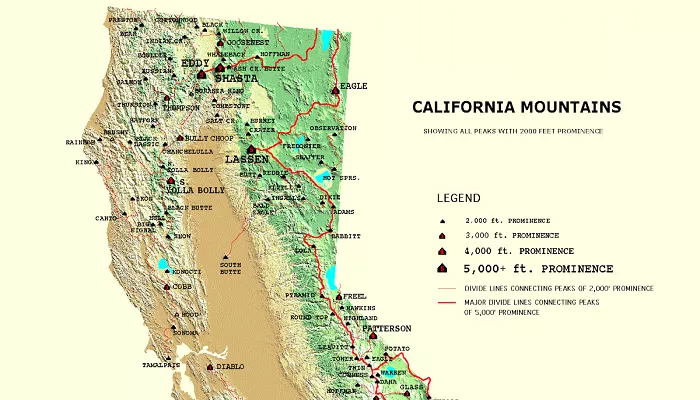California, known for its diverse landscapes, boasts a variety of mountain ranges that significantly shape its geography and climate. From the towering peaks of the Sierra Nevada to the rugged terrains of the Klamath Mountains, these ranges offer both natural beauty and recreational opportunities. Understanding the distribution and characteristics of these mountains enhances our appreciation of California’s rich topographical tapestry.
Major Mountain Ranges in California
1. Sierra Nevada
The Sierra Nevada, meaning “Snowy Range” in Spanish, stretches along California’s eastern edge, forming a natural border with Nevada. This range is renowned for its majestic peaks, alpine lakes, and expansive forests.
- Mount Whitney: The highest peak in the contiguous United States at 14,505 feet, Mount Whitney is a prominent feature of the Sierra Nevada.
- Lake Tahoe Basin: Located on the border between California and Nevada, Lake Tahoe is the largest alpine lake in North America, surrounded by the Sierra Nevada mountains.
- Yosemite National Park: Famous for its dramatic cliffs, waterfalls, and diverse ecosystems, Yosemite is a jewel of the Sierra Nevada.
2. Klamath Mountains
Situated in northwestern California and extending into southwestern Oregon, the Klamath Mountains are characterized by their complex geology and rich biodiversity. This range is notable for its ancient rocks and diverse conifer species.
- Mount Eddy: The highest peak in the Klamath Mountains, Mount Eddy reaches an elevation of 9,025 feet.
- Trinity Alps: Known for their rugged terrain and numerous waterfalls, the Trinity Alps offer extensive hiking opportunities.
- Siskiyou Mountains: A sub-range of the Klamath Mountains, the Siskiyou Mountains are recognized for their unique flora and fauna.
3. Transverse Ranges
The Transverse Ranges are a series of mountain ranges in Southern California that run east-west, perpendicular to the state’s generally northwest-southeast orientation. This alignment contributes to unique geological and climatic conditions.
- San Bernardino Mountains: Home to Mount San Gorgonio, the highest peak in Southern California at 11,503 feet, this range offers diverse recreational activities.
- San Gabriel Mountains: Located northeast of Los Angeles, the San Gabriel Mountains feature peaks like Mount Baldy (Mount San Antonio) and are a popular destination for hikers and campers.
- Santa Monica Mountains: Stretching along the Pacific coast behind Malibu, this range provides scenic views and numerous trails.
4. Coast Ranges
Running parallel to California’s coastline, the Coast Ranges consist of several sub-ranges that influence the state’s climate and ecology.
- Santa Cruz Mountains: Situated between the San Francisco Bay and Monterey Bay, these mountains are known for their redwood forests and vineyards.
- Diablo Range: Located east of the San Francisco Bay Area, the Diablo Range offers expansive views and diverse habitats.
- Gabilan Range: Found in central California, the Gabilan Range includes peaks like Fremont Peak and is known for its rugged terrain.
5. Peninsular Ranges
Extending from Southern California into Baja California, Mexico, the Peninsular Ranges are characterized by their north-south orientation and varied elevations.
- Laguna Mountains: Located in San Diego County, these mountains are part of the Peninsular Ranges and offer diverse ecosystems.
- Cleveland National Forest: Encompassing parts of the Peninsular Ranges, this forest provides numerous recreational opportunities.
Understanding California’s Mountain Geography
California’s mountains are not just geographical features; they play a crucial role in the state’s climate, ecology, and human activities. They influence weather patterns, support diverse ecosystems, and offer recreational opportunities that attract millions of visitors annually.
- Climate Influence: The state’s mountains create rain shadows, affecting precipitation distribution and contributing to California’s varied climates.
- Ecological Significance: These ranges host unique flora and fauna, some of which are endemic to specific mountains or regions.
- Recreational Importance: From skiing in the Sierra Nevada to hiking in the Transverse Ranges, these mountains provide a plethora of outdoor activities.
Conclusion
California’s mountains are as diverse as the state itself, offering a rich tapestry of geological formations, ecosystems, and recreational opportunities. Whether it’s the snow-capped peaks of the Sierra Nevada, the rugged terrains of the Klamath Mountains, or the coastal ranges overlooking the Pacific, these mountains are integral to California’s identity and allure.

